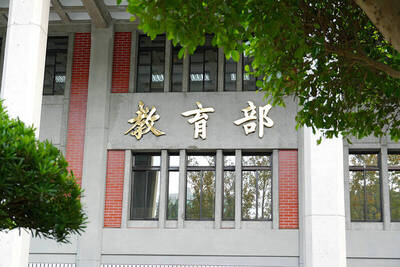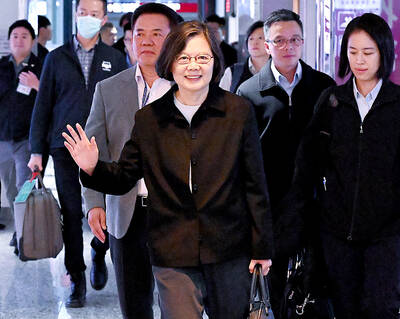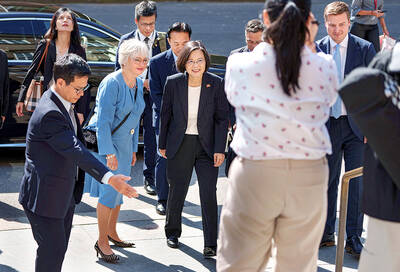Taipei City's Department of Rapid Transit Systems signed an agreement yesterday with Japan's Kawasaki Heavy Industries to build 55 electrical multiple units (EMUs) for the city's mass rapid transit (MRT) systems.
After fierce competition among major bidders, including France's Aston Martin, Germany's Siemens, Japan's Mitsubishi, Bombardier from Cananda and South Korea's Hyundai since early this year, Kawasaki won the NT$15.2 billion (US$447 million) contract to build the 55 EMUs, which will comprise a total of 321 carriages.
The EMUs must be delivered between Oct. 1, 2005 and April 1, 2009 in five shipments. The new carriages will be used on existing MRT lines as well as several new MRT lines scheduled for completion between 2008 and 2009, including the Pitan branch line, the Hsinchuang-Luchou line and the extended section of the Nankang-Panchiao line.
Lee Wen-tsai (李文才), director of the department's electrical and engineering branch, who inked the contract with Kawasaki officials on behalf of the department, denied allegations that Kawasaki won the contract by offering an "unreasonably low price."
Instead, Lee said, Kawasaki offered a "reasonable price" for the contract.
He also said that Kawasaki was awarded the contract because of other reasons, including the fact that the carriages to be used in the proposed high-speed railway system will also be provided by Kawasaki and the existing EMUs used on the MRT Tamshui line were built by Kawasaki -- factors that made the new EMUs procurement pro-ject more financially economical and technically efficient.
According to Frank Fan, a director at the department, Kawasaki-built EMUs have been operating smoothly on the Tamshui line.
Noting that Bombardier had promised to have 163 out of the 202 carriages to be used on the Neihu line assembled by Taiwanese sub-contractors, Fan said Kawasaki has been asked to offer an offset plan as part of the contract as required by the Ministry of Economic Affairs' "industrial technologically cooperation" requirements.
Kawasaki has agreed to have about half of the 321 carriages assembled in Taiwan.
Takehiko Saeki, executive vice president of Kawasaki Heavy Industries promised that shipments of the Kawasaki-built EMUs will be delivered on time, or ahead of schedule.
Saeki said his Kawasaki team will present an offset plan within one year to allow Taiwanese sub-contractors to assemble half of the new carriages, while opening 20 percent of the parts and components purchases to Taiwanese suppliers.

The Ministry of Education (MOE) is to launch a new program to encourage international students to stay in Taiwan and explore job opportunities here after graduation, Deputy Minister of Education Yeh Ping-cheng (葉丙成) said on Friday. The government would provide full scholarships for international students to further their studies for two years in Taiwan, so those who want to pursue a master’s degree can consider applying for the program, he said. The fields included are science, technology, engineering, mathematics, semiconductors and finance, Yeh added. The program, called “Intense 2+2,” would also assist international students who completed the two years of further studies in

Former president Tsai Ing-wen (蔡英文) departed for Europe on Friday night, with planned stops in Lithuania and Denmark. Tsai arrived at Taiwan Taoyuan International Airport on Friday night, but did not speak to reporters before departing. Tsai wrote on social media later that the purpose of the trip was to reaffirm the commitment of Taiwanese to working with democratic allies to promote regional security and stability, upholding freedom and democracy, and defending their homeland. She also expressed hope that through joint efforts, Taiwan and Europe would continue to be partners building up economic resilience on the global stage. The former president was to first

Former president Tsai Ing-wen (蔡英文) on Monday called for greater cooperation between Taiwan, Lithuania and the EU to counter threats to information security, including attacks on undersea cables and other critical infrastructure. In a speech at Vilnius University in the Lithuanian capital, Tsai highlighted recent incidents in which vital undersea cables — essential for cross-border data transmission — were severed in the Taiwan Strait and the Baltic Sea over the past year. Taiwanese authorities suspect Chinese sabotage in the incidents near Taiwan’s waters, while EU leaders have said Russia is the likely culprit behind similar breaches in the Baltic. “Taiwan and our European

The Taipei District Court sentenced babysitters Liu Tsai-hsuan (劉彩萱) and Liu Jou-lin (劉若琳) to life and 18 years in prison respectively today for causing the death of a one-year-old boy in December 2023. The Taipei District Prosecutors’ Office said that Liu Tsai-hsuan was entrusted with the care of a one-year-old boy, nicknamed Kai Kai (剴剴), in August 2023 by the Child Welfare League Foundation. From Sept. 1 to Dec. 23 that year, she and her sister Liu Jou-lin allegedly committed acts of abuse against the boy, who was rushed to the hospital with severe injuries on Dec. 24, 2023, but did not